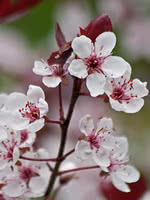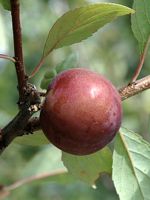Mon-Fri 9am - 5pm Mountain time
Purple Leaf Sand Cherry vs Opata Cherry Plum
Prunus x cistena
Prunus besseyi x salicina Opata
CUSTOM GROW
Purple Leaf Sand Cherry provides bright reddish-purple leaves that turn bronze-green in the fall. In the spring, tiny flowers with a pinkish white hue bloom. The flowers are small, but the impact comes from the shrub blossoming all at once.
The Purple leaf sand cherry can be susceptible to pests and diseases in more humid areas; a typical life span is approximately 15 years. Not suitable for a privacy hedge on its own but is often alternated with lilacs. Often used as an accent plant that attracts birds and bees.
Opata Cherry Plum is considered to be one of the best tasting Cherry Plum varieties. It has a pleasant, sweet flavour and a hint of acidity. They ripen in mid to late August and are well suited to fresh eating, baking, and preserves.
The fruit is closer to a plum than a cherry but is smaller than most plums.The Opata Cherry Plum’s skin is red/green whereas the flesh is yellow-green. The flesh is freestone with a juicy, firm texture. Similar to other stone fruits, it does not store for very long.
The Opata Cherry Plum is a hybrid between a Western Sand Cherry and a Japanese (Chinese) Plum. For fruit production, it needs to be planted with another variety for cross-pollination. Canada Plum and American Plum are considered universal pollinizers.
Purple Leaf Sand Cherry Quick Facts
Opata Cherry Plum Quick Facts
Toxicity: the leaves and seed are slightly toxic

